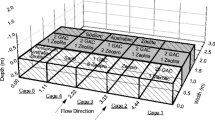Abstract
A white spirit spill at a factory site located in a residentialarea of south eastern Australia led to contamination of shallowgroundwater that fed into a nearby river. The contaminatedgroundwater contained toluene, ethyl benzene, and xylene and n-alkanes in the C6–C36 fraction range. A funnel andgate permeable reactive barrier was designed and built, based onpreliminary pilot scale tests using peat as the medium for thegate and the work conducted is presented as a case study. Thetechnical effectiveness of the funnel and gate, over the 10 monthoperating period in which data was collected, indicates that peatrepresents an effective material for use in the gate component offunnel and gate remedial systems. The application of the funneland gate technology represented a substantial saving to the client and was effective in preventing ongoing pollution of thenearby river. The construction of the funnel and gate system also incurred the minimum disturbance to the public access areasbetween the facility and the river.
Similar content being viewed by others
References
Anonymous: 1994a, ‘Water Quality Criteria: Human Health Partial Body Contact’, U.S. Government.
Anonymous: 1994b, ‘Water Quality Criteria Human Health Fish Consumption’, U.S. Government.
Anonymous: 1994c, ‘Guidelines for Assessing Service Station Sites’, Sydney, NSW, Australia, NSW EPA, 31 pp.
ANZECC: 1992, Australian Water Quality Guidelines for Fresh and Marine Waters, Summary of Water Quality Guidelines for Recreational Waters, Australian New Zealand Environment Conservation Council and National Health and Medical Research Council.
ASTM: 1995, ‘Guide for Risk Based Corrective Action Applied at Petroleum Release Sites’, West Conshohocksen, PA, ASTM Committee E50 on Environmental Assessment, 51 pp.
Bowles, M. W., Bently, L. R, Hoyne, B. and Thomas, D. A.: 2000, ‘In situ ground water remediation using the trench and gate system’, Ground Water 38, 172–181.
Clark, D. K., Darling, D. F., Hineline, T. L. and Hayden, P. H.: 1997, Field Trial of the Biowall Technology at a Former Manufactured Gas Plant Site. 29th Mid-Atlantic Industrial and Hazardous Waste Conference, Presentation by Stearns and Wheler, LLC, Cazenovia, NY, U.S.A.
Cohen, A. D., Rollings, M. S., Zunic, W. M. and Durig, J. D.: 1991, ‘Effects of chemical and physical differences in peats on their ability to extract hydrocarbons from water’, Water Resources Research 25, 1047–1060.
Couillard, D.: 1994, ‘The use of peat in wastewater treatment’ Water Research 28, 1261–1274.
Day, S. R., O'Hannesin and Marsden, L.: 1999, 'Geotechnical techniques for the construction of reactive barriers, J. Hazard. Mat. B, 285–297.
Eykholt, G. R. and Sivavec, T. M.: 1995, Contaminant Transport Issues for Reactive-Permeable Barriers, New York, NY, ASCE, pp. 1608–1621.
Fetter, C. W.: 1988, Applied Hydrology, Oshkosh, Wisconsin, Merill Publishing Company, 592 pp.
Jack, T. R., Francis, M. M. and Stehmeier, L. G.: 1994, ‘Disposal of slop oil and sludges by biodegradation’, Res. Microbiol. 145, 49–52.
Kao, C. M. and Borden, R. C.: 1997, ‘Enhanced TEX biodegradation in nutrient briquet-peat barrier system’, J. Environ. Engin. (New York) 123, 18–24.
Kao, C. M. and Wang, C. C.: 2000, ‘Control of BTEX migration by intrinsic bioremediation at a gasoline spill site’, Water Res. 34, 3413–3423.
McMurty, D. C. and Elton, R. O.: 1985, ‘New approach to in situ treatment of contaminated groundwaters’, Environ. Progr. 4, 168–170.
NEPC: 1999, National Environmental Protection Measure – Schedule B, (1) Guidelines on the Investigations Levels for Soil and Groundwater, Adelaide, Australia, NEPC (National Environmental Protection Council), 11 pp.
Pankow, J., Johnson, R. L. and Cherry, J. A.: 1993, ‘Air sparging in gate wells in cutoff walls and trenches for control of plumes of volatile organic compounds (VOCs)’, Ground Water 31, 654–663.
Rael, J., Shelton, S. and Dayaye, R.: 1995, ‘Permeable barriers to remove benzene: Candidate media evaluation’, J. Environ. Engin. 121, 411–415.
RIVM: 1994, Environmental Quality Objectives in The Netherlands – A Review of Environmental Quality Objectives and Their Policy Frame Work in The Netherlands, Amsterdam, RIVM (Risk Assessment and Environmental Quality Division, Directorate for Chemicals, External Safety and Radiation Protection, Ministry of Housing, Spatial Planning and Environment, The Netherlands).
Schad, H. and Schulze, B.: 2000, Funnel and Gate at a Former Manufactured Gas Plant Site in Karlesruhe, Germany: Design and Construction. Remediation of Chlorinated and Recalcitrant Compounds – Chemical Oxidation and Reactive Barriers, Monterey, California, Battelle Press, pp. 315–322.
Schwartz, F. A. and Domenico, P. A.: 1997, Physical and Chemical Hydrogeology, New York, NY, John Wiley & Sons, 640 pp.
Starr, R. C. and Cherry, J.: 1994, ‘In situ remediation of contaminated groundwater: The funnel and gate system’, Ground Water 32, 465–476.
Stehmeier, L. G.: 1989, Development of an Oclanosorb (TM) (peat) Filter for Separating Hydrocarbons from Bilge Water, Calgary, CA, Nova Husky Research Corporation, 12 pp.
Steimle, R.: 1995, In Situ Remediation Technology Status Report: Treatment Walls, Washington, DC, US EPA, 31 pp.
Thomas, J. M. and Ward, C. H.: 1995, Ground Water for Bioremediation, New York, NY, Geotechnical Special Publication, ASCE, pp. 1456–1466.
Vidic, R. D. and Pohland, F. G.: 1996, Treatment Walls, Pittsburgh, PA, Ground Water Remediation Technologies Analysis Center, 38 pp.
Author information
Authors and Affiliations
Corresponding author
Rights and permissions
About this article
Cite this article
McGovern, T., Guerin, T.F., Horner, S. et al. Design, Construction and Operation of a Funnel and Gate In-Situ Permeable Reactive Barrier for Remediation of Petroleum Hydrocarbons in Groundwater. Water, Air, & Soil Pollution 136, 11–31 (2002). https://doi.org/10.1023/A:1015227530710
Issue Date:
DOI: https://doi.org/10.1023/A:1015227530710




